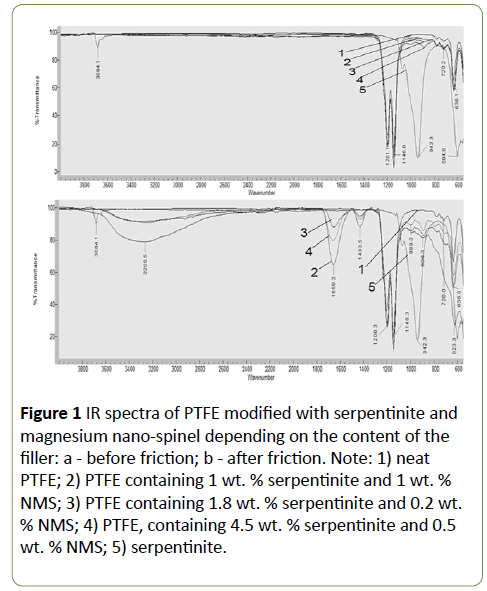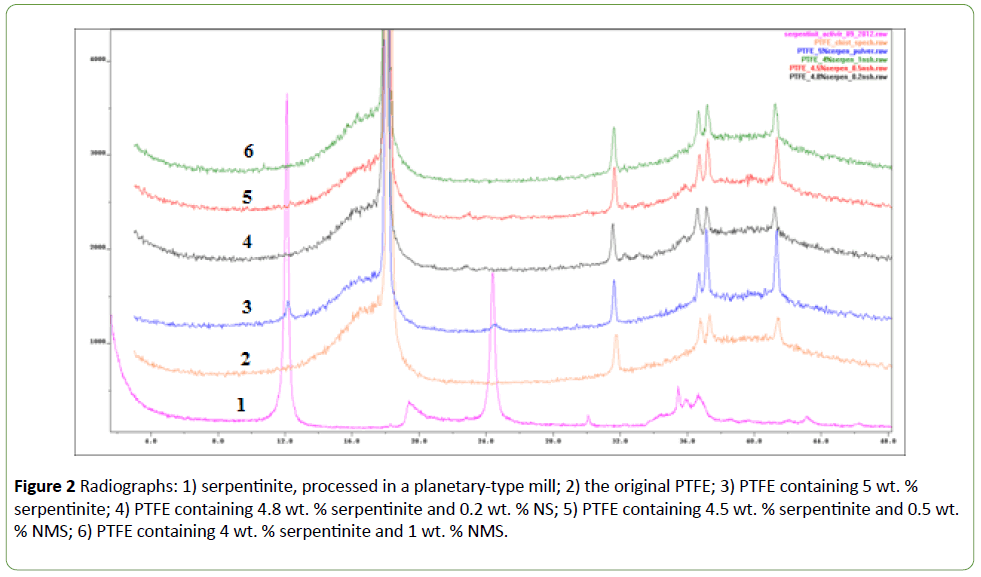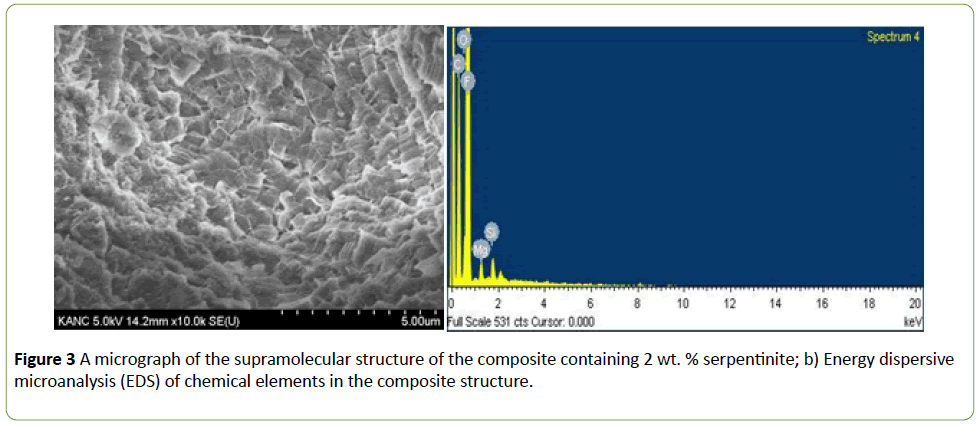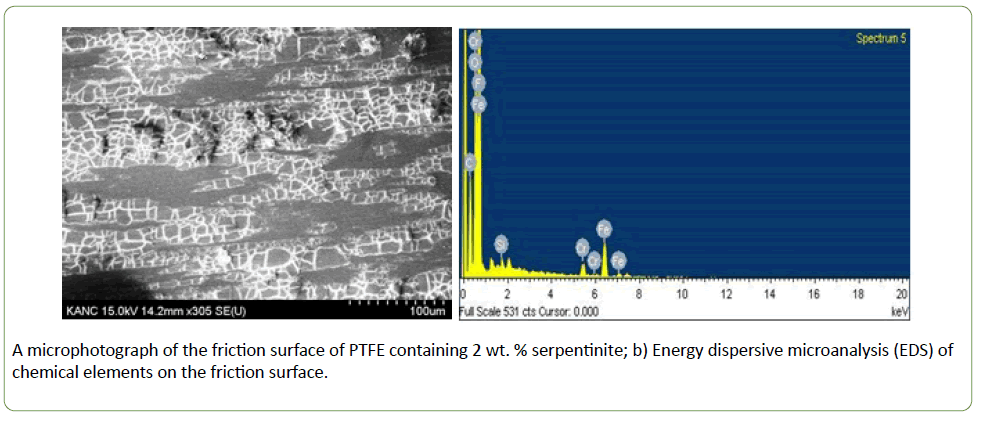h4>Keywords
Nanocomposites; Layered silicates; Polytetrafluoroethylene; Serpentinite
Introduction
One of the most promising approaches to the development of polymer nanocomposites is the use of layered silicates as fillers of polymers, which are widely distributed and are well known as clay minerals. A significant improvement in the properties of the original polymers is achieved in the case of intercalation of polymer macromolecules in the interlayer space of silicates, followed by exfoliation into individual nanolayers dispersed in the polymer volume [1,2]. With regard to the development of tribotechnical materials, interest in layered silicates as fillers of a polymer matrix arises in connection with the prospect of creating self-lubricating polymer nanocomposites. It should be also mentioned [3,4] that with the addition of even a small amount of clay (2-3 wt. %) to the polymer matrix, the coefficient of thermal expansion significantly decreases. Layered natural inorganic structures such as montmorillonite, hectorite, vermiculite, kaolin, saponite [5,6], etc., are used to create polymer-layered nanocomposites. Most of the natural layered silicates commonly used in nanocomposites as nanoscale particles, belongs to a structural family of type 2:1. In layered silicates with similar structure octahedral grid is enclosed between two grids of silicon-oxygen tetrahedra. In tetrahedra, part of the tetravalent silicon is replaced by trivalent aluminum. As a result, a negative charge is formed on the layer, which is compensated by hydrated cations of alkali or alkaline-earth metal enshrined between the layers [7,8]. A partial positive charge, formed on each cation inside the gallery, gives the layered silicates hydrophilicity. This feature of silicates of the 2:1 structure makes it possible to exhibit them as the most effective modifiers with respect to polar polymers, such as polyamide [9,10]. So far polymer-layered nanocomposites with nonpolar or weakly polar polymers are not considered to have such high performance characteristics as materials based on polar polymers [11,12]. Information on the effect of such fillers on the change in the properties of composites based on PTFE is not provided. First of all, this is due to hydrophilicity of the given silicates - the main problem of incompatibility with an organic polymer matrix. To solve this problem, researchers often modify layered silicates with surface-active substances (surfactants) by replacing inorganic cations within silicate layers with organic cations. Substitution by cationic surfactants, such as bulk ammonium and phosphonium ions, increases the space between the layers, reduces the surface energy of the clay, and imparts a hydrophobic character to the clay surface [13-15].
Another promising way to improve the compatibility of layered silicates to the polymer matrix to ensure the intercalation of macromolecules nonpolar polymers in the space between the silicate plates is the use of mechanical activation methods. There are several papers that confirm the effectiveness of these methods [16,17]. The authors of [18] showed the effect of activated layered silicates, vermiculite and serpentinite, on a significant increase in tribological characteristics of PTFE. The structure of the crystal lattice of serpentinite is characterized as 1:1, i.e., for one silicon-oxygen tetrahedral layer there is one octahedral. In the case of serpentinite, the charge of tetrahedra is completely compensated by the charge of octahedra [7]. Consequently, serpentinite does not obviously have hydrophilicity. A comparison of physicomechanical and tribological properties of composites showed that the most optimal complex of properties is characteristic for PTFE containing serpentinite. In PTFE containing vermiculite, the increase in tribotechnical characteristics occurs against a background of a sharp decrease in its deformation-strength properties. These data may indicate the influence of the type of crystal lattice structure of layered silicate for their compatibility with the nonpolar polymer matrix. In the paper [19] the data on the use of nonionic modifiers, which bind to the surface of the clay through hydrogen bonds are discussed. It is indicated that in some cases organoclays obtained using nonionic modifiers are chemically more stable than organoclays obtained using cationic modifiers. In this paper, an attempt has been made to more effectively improve the compatibility of serpentinite with PTFE by using active nanodispersed compounds as modifiers of serpentinite.
The purpose is to study the combined effect of mechanically activated serpentinite and nanodispersed spinel on the properties of PTFE.
Objects and Methods of Research
The objects of the study were polymer composite materials based on grade Mo PTFE (GOST 10007-80), with density 2150-2190 kg/cm3, modified by natural layered silicate - serpentinite and composites containing mechanoactivated serpentinite and magnesium nano-spinel. The serpentinites are magnesium hydrosilicates of general formula Mg6[Si4O10] (OH)8, formed by alteration of olivine rocks. They consist mainly of serpentine group minerals mixture: fibrous chrysotile, plate-shaped antigorite and massive lizardite, and according to the prevailing mineral composition, the antigorite, chrysolite, lizardite serpentinites are distinguished respectively. Serpentinite used in the work refers to the antigorite. Differences between serpentine groups’ minerals are due to both chemical composition and different way of overlay and combination of two structural elements - siliconoxygen tetrahedra and brucite-like layers and strains of their structures [20].
Magnesium nano-spinel (NMS) is a complex compound with the general formula MgO-Al2O3. It is solid interstitial solution obtained by the plasma-chemical method in IHTTM (Novosibirsk). The medium particle size is 70-90 nm, specific surface is 170 m2/g.
Serpentinite was dried in an oven at 120°C for 6 hours to completely remove adsorbed water [11,20]. The dried serpentinite was exposed to activation planetary type "Activator-2S” mill for 2 minutes with the speed of 2000 rpm Drum/min. NMS was introduced into the previously mechanoactivated powder of serpentinite.
Composites were prepared by dry mixing polymer with filler, using cold forming technology followed by a free sintering.
Physical and mechanical properties of composites are characterized by elongation at break, tensile strength and elastic modulus using standard techniques (GOST 11262-80); they were tested in machines "UTS-2" (Germany), Shimadzu AGS-J (Japan) at room temperature and velocity of the movable grippers was 100 mm/min. The wear rate and the coefficient of friction were determined on a friction machine SMC-2 (Russia) according to the friction scheme "shaftbushing", at the load of 0.45 MPa, and sliding speed 0.39 m/s (GOST 11629-75).
For structural studies methods SEM, EDS, IR spectroscopy and XRD were used. Photomicrographs of chipping and friction surface of filled polymeric systems with energy dispersive microanalysis were obtained in a scanning electron microscope Jeol JSM-78000F (Japan) and HITACHI S-4800 (Japan). Lowtemperature brittle chips were prepared by the destruction of samples at the temperature of liquid nitrogen. To create an electrically conductive structureless film of 10 nm thick, vacuum deposition with gold was used. IR spectra were recorded using a FTS 7000 Fourier-step-scan spectrometer (USA). X-ray diffractogram was obtained using diffractometer ARL X'TRA (Switzerland) with CuKa radiation (?=1.5405 Å) under scanning in increments of 0.04 and the accumulation time at each point within 3 seconds.
Results and Discussion
Analysis of physico-mechanical and tribological tests (Table 1) demonstrates that composites comprising serpentinite and magnesium nano-spinel exhibit highest values of strength and wear resistance characteristics.
| Filler content, % by weight |
Elasticity modulus |
Breaking strength at break |
Elongation at break |
Mass Wear Rate |
Coefficient of friction |
| E, MPa |
Δ σ p, MPa |
Δ ε p,% |
I, mg / h |
f |
| 0 |
479 |
19-21 |
320 |
May-07 |
0.2 |
| 0.5 S |
506 |
16-18 |
297 |
3.6 |
0.18 |
| 1.0 S |
522 |
18-20 |
335 |
3 |
0.17 |
| 2.0 S |
518 |
16-18 |
316 |
0.18 |
0.18 |
| 5.0 S |
575 |
14-16 |
272 |
0.07 |
0.19 |
| 7.0 S |
560 |
11-13 |
245 |
0.05 |
0.2 |
| 1.0 S + 1.0 NMS |
490 |
22-24 |
356 |
0.13 |
0.22 |
| 1.5 S + 0.5 NMS |
468 |
20-22 |
317 |
1.07 |
0 21 |
| 1.8 S + 0.2 NMS |
523 |
21-23 |
329 |
2.23 |
0.25 |
| 4.0 S + 1.0 NMS |
539 |
20-22 |
320 |
0.03 |
0.23 |
| 4.5 S + 0.5 NMS |
558 |
21-23 |
344 |
0.03 |
0.2 |
| 4.8 S + 0.2 NMS |
576 |
19-21 |
336 |
0.27 |
0.28 |
Table 1: Physico-mechanical characteristics and tribological tests of composites based on PTFE.
The level of characteristics of the composites comprising serpentinite and NMS essentially depends on the ratio of these modifiers. The relatively high NMS content leads to an increase in the tensile strength, while an increase in the silicate content in the range of 5 wt. % increases the wear resistance of the material.
The use of layered silicates as modifiers of the polymeric matrix contributes to a significant improvement of the tribological characteristics of PTFE: marked decrease in wear rate of mass to 2500 times in comparison with the initial polymer composites are characterized by a lower value of friction coefficient. One of the possible factors for increasing the wear resistance of these materials can be an increase in the adhesive interaction of the components in the composite due to the effective participation of magnesium nano-spinel in the formation of the boundary layer at the "polymerserpentinite" interface. In addition, the structurally active filler can contribute to an increase in the orientation and order of the macromolecules in friction, participating in the tribochemical processes of tribo-destruction of the polymer and subsequent structuring [21].
Figures 1a and 1b represent IR absorption spectra of activated fillers and composites samples before and after rubbing according to the degree of filling. As can be seen from Figure 1a, the most intense bands relate to the stretching vibrations of CF2 (1211 cm-1 and 1154 cm-1) and vibration ? (CC), which manifests itself as the inflection at 1233 cm-1. In the area below 650 cm-1 there are deformation and out-ofplane vibrations of groups CF2 [22].It is known that under frictional loading [23] chemical activation of the interacting surfaces takes place: the polymer molecules are broken by chemical bonds of main valences side groups, cleaving of side groups and active centers emerge (free microradicals, ionradicals, etc.).

Figure 1: IR spectra of PTFE modified with serpentinite and magnesium nano-spinel depending on the content of the filler: a - before friction; b - after friction. Note: 1) neat PTFE; 2) PTFE containing 1 wt. % serpentinite and 1 wt. % NMS; 3) PTFE containing 1.8 wt. % serpentinite and 0.2 wt. % NMS; 4) PTFE, containing 4.5 wt. % serpentinite and 0.5 wt. % NMS; 5) serpentinite.
This gap is not only due to mechanical degradation, but also thermal degradation, which causes intensive heat generation at the contact [23]. In Ignat’eva and Stolarski study, [24,25] it is assumed that in a technological mode there is possibility of thermal degradation of PTFE followed by its oxidation.
At IR spectra of composites subjected to friction Figure 1b in the range from 3600 cm-1 2600 cm-1 the emergence of broad absorption band can be observed. The filler content increases the intensity of these bands. It is known that the formation of narrow absorption bands in this field is characteristic for free, non-associated hydroxyl groups of alcohols. In the work of Nakanishi [26] it is mentioned that the appearance of a broad absorption band in the area, characteristic for the OH-bond vibrations is associated with the formation of a "chelate-type hydrogen bond". According to the course of organic chemistry we know that during oxidation of hydrocarbons a number of molecular products are produced: hydroperoxides, alcohols, ketones, aldehydes, carboxylic acids, esters and some more complex polyfunctional substances. Oxidation of the saturated carbon atom is carried out most frequently by the free-radical mechanisms, and they can be divided into thermal (autoxidation) and catalyzed by metal salts of variable valency. Hydroperoxides are among rather unstable compounds that transform into other products during oxidation. Therefore, their concentration in the reaction mass, especially under catalytic oxidation or at elevated temperatures is low. Alcohols and carbonyl compounds are the following hydrocarbons oxidation products. The resulting carbonyl and carboxyl groups due to low stability can subsequently form salts of carboxylic acids with the participation of metal cations of excipients or counterbody. In our case, in the range 1680-1400 cm-1 in IR spectra of composites (1b) there are 2 visible characteristic peaks assigned to the fragments of carboxylic acids salts [26].
These results are consistent with the data set forth in Belyi’s study [23] which shows the effect of some metals on thermoand tribooxidation of polymers: metal in the initial stages of polymer processing initiates oxidative processes leading to the formation of carboxylate anions. Judging by peaks (1b), the intensity increase of the NMS acts as an active catalyst of crosslinking fragments of macromolecules tribological decay structuring agents and surface layers, which leads to such a significant increase in wear resistance of the composites.
To investigate the structure of the PTFE filled with mineral fillers, the method of X-ray powder diffractometry was used. Figure 2 shows the X-ray scattering curves of samples of initial serpentinite and composites with different contents of serpentinite and NMS. As seen from the X-ray, the peak corresponding to the basal reflex of the original silicate layers characterizing periodicity manifests itself in a composite containing 5 wt.% of serpentinite (2? =~12°). In the PTFE samples radiographs containing serpentinite and NMS (curves 4 and 5), this peak is not observed. The disappearance of the basal reflex indicates complete exfoliation of particles on serpentinite monolayers as a result of the intercalation of the polymer macromolecules in the interlayer space silicate (exfoliated nanostructure formation) [27]. It is observed that peak 6 on the curve of the original silicate is shifted toward low angles, indicating an increase in the interplanar spacing silicate in the nanocomposite structure, but with the preservation of the ordered layered structure of serpentinite particles (intercalated nanostructure formation) [11].

Figure 2: Radiographs: 1) serpentinite, processed in a planetary-type mill; 2) the original PTFE; 3) PTFE containing 5 wt. % serpentinite; 4) PTFE containing 4.8 wt. % serpentinite and 0.2 wt. % NS; 5) PTFE containing 4.5 wt. % serpentinite and 0.5 wt. % NMS; 6) PTFE containing 4 wt. % serpentinite and 1 wt. % NMS.
To study the structure and chemical composition of the composites in the volume and on the friction surface, electron microscopy was used in conjunction with energy dispersive microanalysis (EDS). Figure 3a shows photomicrograph of the PTFE supramolecular structure containing 2 wt. % of serpentinite.
The PCM structure is characterized by forming homogeneous structural elements, wherein the silicate particles disintegrations are distributed evenly. The obtained data using energy dispersive microanalysis Figure 3b indicate the presence of elements such as C, F, O, Mg, Si in the composite volume.

Figure 3: A micrograph of the supramolecular structure of the composite containing 2 wt. % serpentinite; b) Energy dispersive microanalysis (EDS) of chemical elements in the composite structure.
On Figure 4a there is a photomicrograph of friction surface structure of PTFE containing 2 wt.% of serpentinite.
In the photomicrograph portions of serpentinite are clearly visible, extruded onto the surface as a result of friction and oriented along the sliding direction. Serpentinite localized on the friction surface due to its layered structure acts as a lubricant, helping to improve the wear resistance of the material and reduce the friction coefficient. Elemental analysis data Figure 4b indicates the appearance of counterbody elements - chromium and iron on the friction surface.

Figure 4: A microphotograph of the friction surface of PTFE containing 2 wt. % serpentinite; b) Energy dispersive microanalysis (EDS) of chemical elements on the friction surface.
Conclusion
The new self-lubricating composite materials characterized by high wear resistance have been developed. The obtained materials with a low filler content (2-5 wt.%) have substantially improved properties of the complex as compared with commercially produced composites based on PTFE. The application efficiency of complex modification of PTFE tribological materials has revealed that simultaneous administration of serpentinite and magnesium nano-spinel as the PTFE filler greatly improved the wear resistance of the material (up to 2.500 times), while maintaining high values of strength characteristics. It has been shown that the addition of magnesium nano-spinel promoted formation of exfoliated and intercalated polymer-silicate nanostructures.
Acknowledgments
This work was supported by grant of NEFU, assignment no. 13-NIP.
References
- Alexandre M, Dubois P (2000) Polymer-layered silicate nanocomposites: Preparation, properties and uses of a new class of materials. Mater Sci Eng R Rep 28: 1-63.
- Ray SS, Okamoto M (2003) Polymer/layered silicate nanocomposites: A review from preparation to processing. Prog Polym Sci 28: 1539-1641.
- Lan T, Kaviratna PD, Pinnavaia TJ (1994) On the nature of polyimide-clay hybrid composites. Chem Mater 6: 573-575.
- Yano K, Usuki A, Okada A (1997) Synthesis and properties of polyimide-clay hybrid films. J Polym Sci A: Polym Chem 35: 2289-2294.
- Beall GW, Tsipursky SJ (1999) Chemistry and technology of polymer additives.
- Beslaneeva VL (2011) Novye organogliny i polietilen-sloistosilikatnye nanokompozity. Diss kand tech nauk.
- Krasil’nkov PV (2000) Praktikum po geologii (Practical work on Geology), Petrozavodsk: PetrGU.
- Pinnavia TJ (1983) Intercalated Clay. J Catalysts Science 220: 365-371.
- Kojima Y, Usuki A, Kawasumi M, Okada A, Kurauchi T, et al. (1993) Synthesis of nylon 6-clay hybrid by montmorillonite intercalated with e-caprolactam. J Polym Sci A 31: 983-986.
- Kojima Y, Usuki A, Kawasumi M, Okada A, Kurauchi T, et al. (1993) One-pot synthesis of nylon 6-clay hybrid. J Polym Sci A 31: 1755-1758.
- Gerasin VA, Zubova TA, Bakhov FN (2007) Structure of polymer/Na+- montmorillonite nanocomposites, obtained via mixing in melt. Ross. Nanotechnologii 2: 90-105.
- Gerasin VA, Bakhov FN, Merekalova ND, Korolev Yu M, Fischer HR, et al. (2005) Structure of surfactant layers formed on Na+ montmorillonite and compatibility of the modified clay with polyolefins. Polym Sci Ser A 47; 954-964.
- LeBaron PC, Wang Zh, Pinnavaia TJ (1999) Polymer-layered silicate nanocomposites: an overview. Appl Clay Sci 15: 11-29.
- Tortora M, Gorrasi G, Vittoria V, Galli G, Ritrovati S, et al. (2002) Structural characterization and transport properties of organically modified montmorillonite/polyurethane nanocomposites. Polymer 43: 6147-6157.
- Moraru VN, Markova SA, Ovcharenko FD (1981) Adsorption of cationic surfactants on montmorillonite from aqueous solutions. Ukrainian Chem J 1981, 47; 1062-1063.
- Mahfuz H, Islam MS, Rangari VK, Saha MC, Jeelani S (2004) Response of sandwich composites with nanophased cores under flexural loading. Composites Part B: Engineering 35; 543-550.
- Wang G, Chen Y, Wang Q (2008) Structure and properties of poly(ethylene terephthalate)/Na+-montmorillonite nanocomposites prepared by solid state shear milling (S3M) method. J Polym Sci 46; 807-817.
- Sleptsova SA, Afanas’eva ES, Grigor’eva VP (2009) Structure and tribological behavior of polytetrafluoroethylene modified with layered silicates. Journal of Friction and Wear 30; 431–437.
- Delozier DM, Orwoll RA, Cahoon JF, Ladislaw JS, Smith JG, et al. (2003) Polyimide nanocomposites prepared from high-temperature, reduced charge organoclays. Polymer 44; 2231–2241.
- Nazharova LN (1999) Solyanokislaya pererabotka serpentinita. Diss. kand. tekhn. nauk (Hydrochloric acid processing of serpentinite: Cand tech sci diss Kazan.
- Okhlopkova AA (2000) Physicochemical principles of creating tribotechnical materials based on polytetrafluoroethylene and ultradispersed ceramic. Dr tech sci diss Gomel.
- Ignat’eva LN, Buznik VM (2009) IR-spectroscopic examination of polytetrafluoroethylene and its modified forms, Russ. J Gen Chem 79; 677– 685.
- Belyi VA, Egorenkov NI, Pleskachevskii Yu M (1987) Thermo-and tribo-oxidation processes in polymers. Moscow: Khimiya.
- Ignat’eva LN, Tsvetnikov AK, Livshits AN, Saldin VI, Buznik VM (2003) Spectroscopic research of modified polytetrafluoroethylene. Zh Strukt Khim 43; 69–73.
- Stolarski T, Olszewski O (1976) An experimental study of the frictional mechanism in a journal bearing lubricated with grease containing powdered PFTE. Wear 39; 377-387.
- Nakanishi K (1965) Infared spectra and structure of organic compounds. Practical Guidance, Maltsev, AA (ed) Wiley, New York, USA.
- Brevnov PN (2008) Nano composite materials based on polyethylene and montmorillonite: synthesis, structure, properties. Author's abstract. Diss Cand Chem Sci, Moscow.





